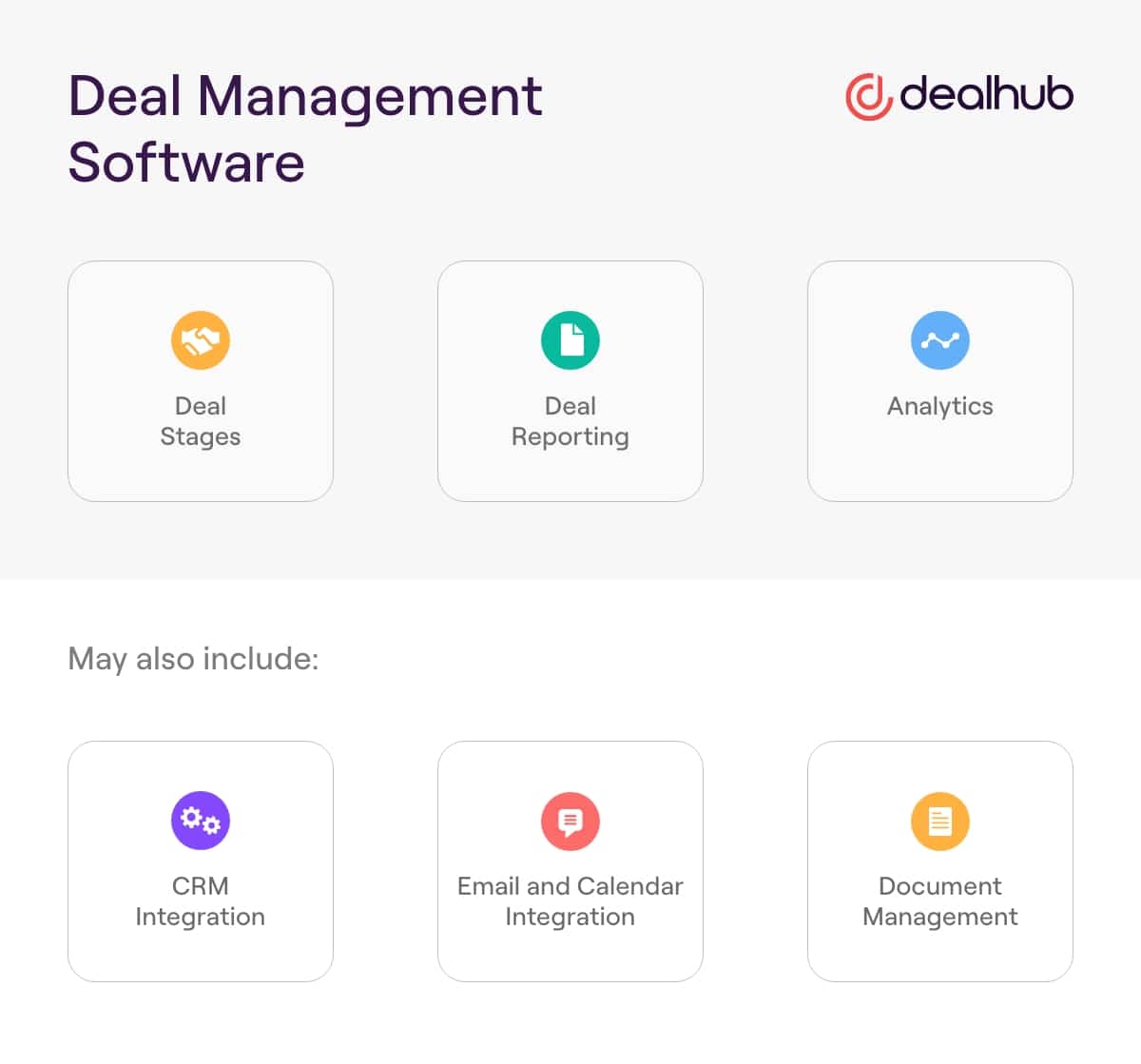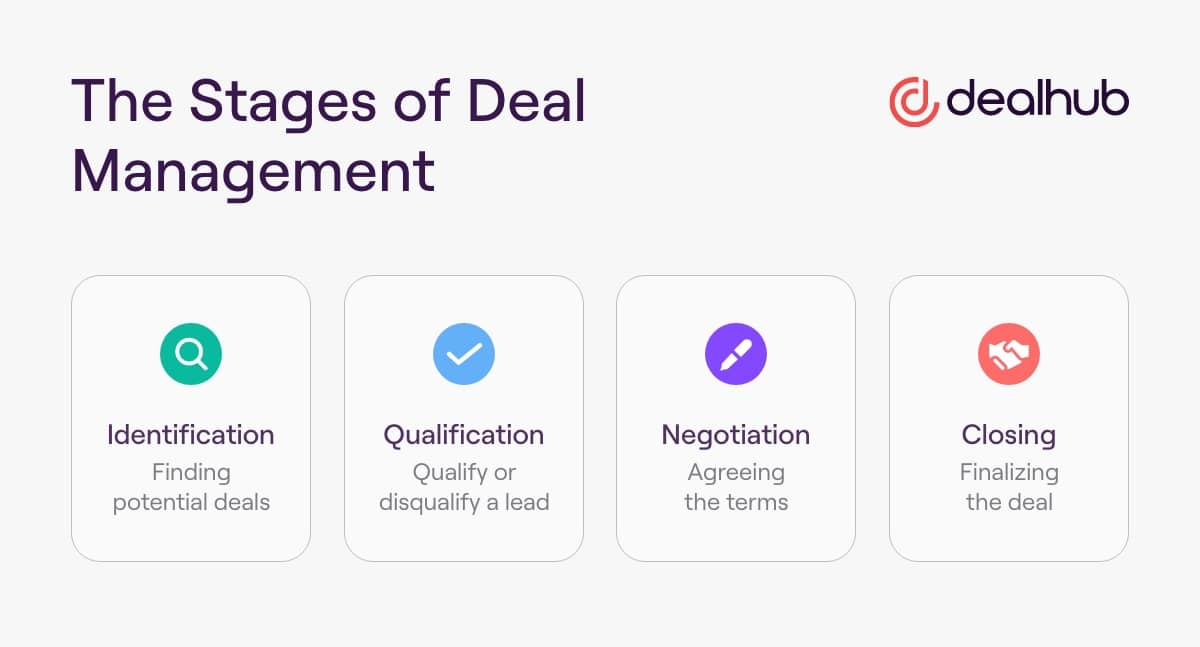Deal Management
Table of Contents
What is Deal Management?
Deal management is the sales operations process of overseeing and coordinating all aspects of a deal, from start to finish. This includes identifying and pursuing opportunities, negotiating terms, and ensuring that all parties involved are satisfied with the outcome.
The goal of deal management is to get the best possible result for all parties involved in the deal. This means finding the right balance between meeting the needs of the buyer and the seller, and ensuring that everyone is happy with the final deal.
To succeed in deal management, it is important to understand both the buyer’s and the seller’s needs. It is also important to be able to negotiate effectively and to have a good understanding of the legal aspects of a deal. Deal management is a complex process, but if it is done well, it can result in a successful outcome for all parties involved.
Deal Management Software
Deal management software provides a systematic way to track, manage and monitor the progress of deals through each stage of the sales pipeline. By automating key tasks and processes, deal management software can help sales teams close more deals in less time while providing visibility into deal progress and performance.
Deal management software typically includes deal tracking, deal stages, deal reporting, and analytics. It may also include CRM integration, email and calendar integration, and document management. Some deal management software solutions are designed for specific industries, such as real estate or venture capital, while others are more general.

The Stages of Deal Management
The deal process can be complicated with multiple steps, different parties, and departments involved. The deal process is a series of activities that guides sales reps through every step as they develop an effective method to handle each deal and get them closed.

Deal management can be broken down into four key stages: identification, qualification, negotiation, and closing.
- Identification is the process of finding potential deals that fit your criteria. This stage requires market research and a clear understanding of what you’re looking for.
- Qualification is the process of determining whether a deal is a good fit for your company. This stage includes assessing the deal’s financials, evaluating the customer’s needs, and understanding the competition.
- Negotiation is the process of agreeing to the terms of the deal. This stage requires strong communication and negotiation skills and is often performed by the deal desk team.
- Closing is the process of finalizing the deal. This stage includes signing the contract and ensuring that all paperwork is in order.
The Benefits of Deal Management
There are many benefits to having a deal management system in place. Perhaps the most obvious benefit is that it can help you close more deals and increase your sales productivity. But there are other advantages too, including:
Create Consistency in Deal Processes
Sales is all about closing deals. However, every salesperson will approach them differently. To standardize processes, you need to define what you’re trying to accomplish. You’ll then need to set parameters around those goals. For example, if you want to sell at a specific price, you should establish a minimum acceptable price. Once you’ve defined these parameters, you can begin to train your salespeople to follow the same guidelines.
Improve the Sales Experience for Customers
Sales leaders often struggle to keep pace with trends in technology, customer expectations, and competitive pressures. To stay ahead of the competition, they need insights into what works well, what doesn’t, and why. But when sales leaders try to implement best practices, they face challenges like inconsistent adoption rates and a lack of alignment among teams. That’s why you need a platform that helps sales leaders quickly identify and prioritize opportunities for improvement, then deploy them effectively across the entire sales organization.
Optimize Pricing
There are many ways to optimize pricing to maximize profit margins in today’s market. By implementing a deal management solution, you can move past guessing at the right price and instead make those determinations based on historical transactional data. Deal management software combines pricing data and inventory information to help teams make intelligent buying decisions. It helps them avoid losing sales opportunities because of poor pricing. These tools give teams complete visibility into the prices of all company products and services. They also provide real-time alerts when there are changes to prices or availability. Teams can then quickly react to these changes and adjust their offers accordingly.
Provide Visibility and Oversight
Salespeople spend an average of four days closing a sale, and the longer a deal takes to complete, the less likely it will get done. Sales processes are often complex and slow, making it harder for salespeople to hit their quotas. If sales managers aren’t aware of the status of deals, they won’t be able to address problems quickly.
A technology solution that provides insight into the sales process, such as a revenue amplification platform, can help sales leaders and reps identify bottlenecks and fix them before they become deal killers. Price optimization is critical to ensuring deals get closed. It helps ensure salespeople spend time on suitable activities without wasting time on unproductive ones.
How to Implement Deal Management
There are a few key things to keep in mind in order to ensure successful deal management implementation. First, it’s important to have a clear and concise process in place that everyone on the team understands. This will help to avoid confusion and ensure that all deals are properly tracked.
Another important aspect of deal management is communication. It’s important to keep all team members updated on the status of each deal, as well as any changes that occur. This way, everyone is on the same page and can provide input or assistance when needed.
Finally, it’s also important to have a system in place for tracking deals. This can be something as simple as a spreadsheet or CRM system. Having all of the relevant information in one place will make it easier to manage and keep track of deals.
By following these tips, you can be sure that your deal management process is as smooth and successful as possible.
Synonyms
- deal pipeline management
- deal flow management
- sales deal management
- deal funnel tracking
People Also Ask
What is a deal in a CRM?
A deal, also known as a sales opportunity, is a record of potential revenue in a CRM system. Deals are typically associated with a particular account and contact, and they contain information about the products or services being offered, the expected value of the deal, the status of the deal, and other relevant details.
Salespeople use deals to track their progress in winning new business, and CRMs typically provide a variety of reports and dashboards that give managers visibility into the deals in their pipeline. Deals are an important part of the sales process, and they can be a helpful way to measure success and identify areas for improvement.
Why is deal management important?
Deal management is important for many reasons. First, it helps ensure that deals are correctly structured and that all parties involved are aware of the terms of the deal. This can help avoid misunderstandings and disputes down the road.
Second, deal management can help streamline negotiating and closing deals. By keeping track of all the details and communicating with all the parties involved, deal managers can help ensure that deals are completed quickly and efficiently.
Finally, deal management can help ensure that deals are profitable for all parties involved. By keeping track of costs and revenues, deal managers can help make sure that everyone involved in a deal is getting a fair return on their investment.
What is a deal cycle?
A deal cycle is the process that a company goes through in order to secure a new customer or client. It typically includes four key stages: prospecting, pitch, close, and post-sale.
The first stage, prospecting, is all about generating leads and identifying potential customers who may be interested in what you have to offer.
This is usually done through market research, networking, and online lead generation tactics.
Once you’ve identified a potential customer, the next stage is to make your pitch. This is where you’ll provide them with more information about what you have to offer and try to persuade them to do business with you. The key here is to be clear and concise, and let them know how your solution adds value and solves their problem.
If the customer is interested, the next stage is to close the deal. This is where you’ll work out the details of the transaction and get them to agree to do business with you.
Finally, there’s the post-sale stage. This is where you’ll follow up with the customer to make sure they’re happy with what they’ve purchased and to see if there’s anything else you can do for them.

